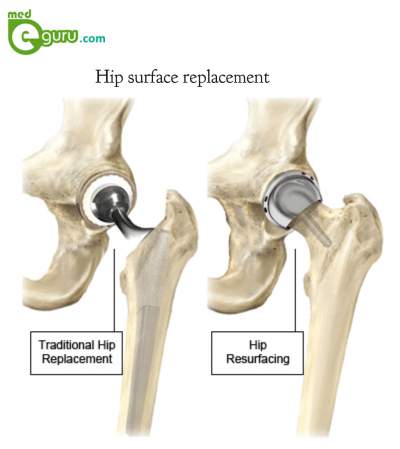What is hip surface replacement?
Even though hip surface replacement is a kind of hip replacement procedure, it has differences. The femoral head and the damaged socket are both cutout in a traditional hip replacement surgery. Where in a hip surface replacement, the femoral head is not removed. It is trimmed and covered with a metal cap. The damaged cartilage and bone will be removed and a metal shell is placed as in the traditional hip replacement procedure.
What are the advantages and disadvantages of having hip resurface replacement surgery?
When comparing with the traditional total hip replacement surgery, it has advantages and disadvantages. Some orthopedician considers hip surface replacement as more advantageous, whereas, some consider it as less advantageous. Thorough researches are still being run among scientists regarding this controversy. However, the advantages of hip surface replacement surgery over total hip replacement include:
It is easier to revise when needed: The implants may wear out over time. But, it can be corrected with a second or revised procedure.
- Increased range of movements of the hip
- Chance for hip dislocation is less
- More walking pattern
Disadvantages
- Hip resurfacing is a difficult procedure
- There can be metal ion risk
- There is a chance for femoral neck fracture
Who can be a candidate for hip resurfacing surgery?
Patients with advanced osteoarthritis condition are usually considered as a candidate for hip resurfacing. Hip resurfacing is not meant for all patients. It is recommended only in severe conditions. Patients younger than 60 -year -old are considered as the best candidates for hip resurface replacements. Apart from that, the patient should have strong and healthy bone. Otherwise, the surgery can be riskier. The orthopedic surgeon will determine the right candidate for hip resurfacing surgery after a comprehensive evaluation.
How is hip surface replacement surgery done?
The hip resurfacing procedure will take around 1 ½ – 3 hours time to complete. After giving anesthesia, the surgeon will make a cut or incision in the patient’s thigh. Through the incision, the surgeon can reach till the hip joint. The femoral head is then moved out of the socket. After that, the femoral head is trimmed using special instruments. The femoral head is then prepared and a metal cap will be cemented over it. A metal cup is also placed into the socket. After that, the femoral head is relocated to the normal position and the incision is closed with sutures.
What are the risks and complications of hip surface replacement surgery?
There can be minimal risks and complications with any surgery. Hip surface replacement surgery complications include:
- Femoral neck fracture
- Dislocation
- Anesthetic risks
- Blood clots
- Infections
- Nerve injury
What about the recovery after the surgery?
The patient may need to stay in the hospital for 1-4 days after the surgery. The doctor may suggest using a walker, cane or crutches for a few days or weeks after the surgery. Physical therapy and exercises may also suggest during the recovery period. For better results, follow-up visits and consultation are necessary.
What is the cost of hip surface replacement?
The cost may vary according to different countries and hospital. However, the cost is lesser in India when compared to other countries.
Orthopedic Solutions from our Doctors and Hospitals
Hip Surface Replacement Doctors in DelhiHip Surface Replacement Doctors in ChennaiHip Surface Replacement Doctors in PuneHip Surface Replacement Doctors in MumbaiHip Surface Replacement Doctors in BangaloreHip Surface Replacement Doctors in KolkataHip Surface Replacement Doctors in HyderabadHip Surface Replacement Doctors in KochiHip Surface Replacement Doctors in AhmedabadHip Surface Replacement Doctors in Surat
